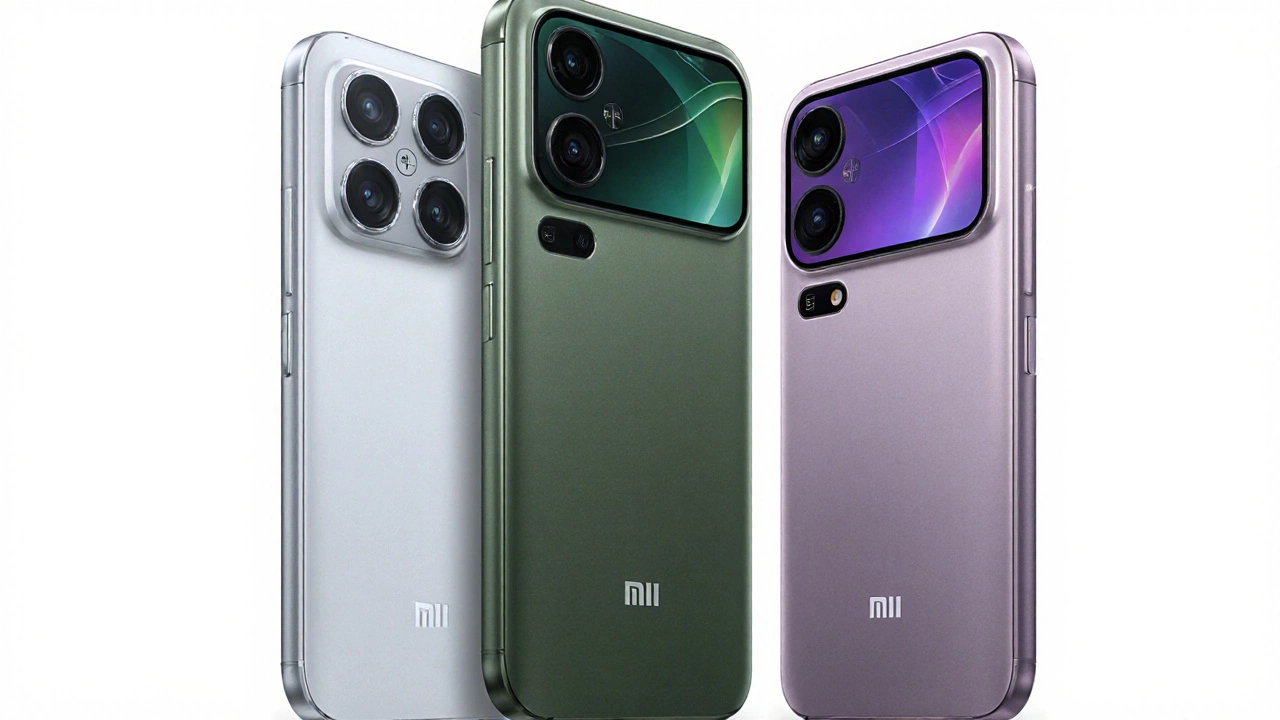- Home
- Technology And Streaming Services
- Xiaomi 17 Series Hits China with Snapdragon 8 Elite Gen 5, Introducing Base, Pro and Pro Max

Xiaomi 17 Series Hits China with Snapdragon 8 Elite Gen 5, Introducing Base, Pro and Pro Max
Design, Display and Battery Power
When Xiaomi threw open its curtains at 7 p.m. Beijing time, the first thing fans noticed was a surprisingly uniform look across three devices. All three share a 6.3‑inch flat LTPO OLED panel with a 19.6:9 aspect ratio and razor‑thin 1.18 mm bezels, a choice that gives the phones a sleek, pocket‑friendly silhouette.
The base Xiaomi 17 sticks to a classic setup: 12 GB or 16 GB of RAM, storage options of 256 GB or 512 GB, and a price tag of CNY 4,499 (about $630). What really makes it stand out is a gigantic 7,000 mAh battery paired with 100 W wired charging and 50 W wireless charging. For a mid‑tier phone, that’s a marathon‑grade power pack.
Stepping up, the 17 Pro keeps the same screen dimensions but adds a “Dynamic Back Display,” a 2.66‑inch secondary OLED panel that curves around two of its four 50 MP cameras. Xiaomi markets this rear screen as a hub for quick notes, animated wallpapers, and media controls—basically a mini‑tablet on the back of your phone. Configurations range from 12 GB/256 GB to a beastly 16 GB/1 TB, with prices beginning at CNY 4,999 (roughly $700).
The flagship 17 Pro Max pushes the envelope further. It inherits the rear display but replaces the main screen’s traditional pixel matrix with an independently arranged RGB pixel stack. Xiaomi says this eliminates “pixel pooling” and slashes power draw by 26 % compared with conventional 2K panels. Battery capacity jumps to 7,500 mAh, still supporting 100 W wired charging, and the starting price climbs to CNY 5,999 (about $840).
All three phones boast Xiaomi’s proprietary M10 luminescence technology, which the company claims hits a record 82.1 cd/A in luminous efficiency. In practice, that translates to bright, colorful visuals while sipping less power—an especially useful trait for those massive batteries.
Innovations and Market Strategy
Behind the hardware, the real headline is Snapdragon 8 Elite Gen 5, Qualcomm’s latest flagship chipset. This is the first time an Android device has shipped with the chip, and it promises a noticeable lift in AI processing, gaming graphics, and power efficiency. Coupled with Xiaomi’s new Hyper OS 3, users can expect smoother multitasking and tighter integration of the rear display features.
Battery tech gets another upgrade with the so‑called Jinshajiang cells. These use an L‑shaped stacked layout and a higher silicon content (16 %) to boost energy density while keeping charging times short. Both Pro models share this battery architecture, and the Pro Max enjoys an even larger capacity without adding bulk.
From a competitive angle, Xiaomi isn’t shy about taking on Apple. During the launch, the brand ran side‑by‑side tests showing the 17 series lasting longer than the iPhone 17 even when the iPhone was paired with a 5,000 mAh MagSafe pack. The messaging was crystal clear: more juice, more features, lower price.
Pricing reflects that ambition. While Apple’s iPhone 17 starts north of $900 in China, Xiaomi’s top‑end Pro Max undercuts it by roughly $60, yet throws in a higher‑resolution display and a rear screen that Apple doesn’t even hint at.
Pre‑orders opened the moment the presentation ended, and the phones hit retail shelves on September 27. For now, the series is China‑only, but Xiaomi has hinted at a global rollout in early 2026, likely aligning with the Mobile World Congress in Barcelona. Analysts expect that launch to be the moment Xiaomi finally tests the full‑stack of Snapdragon 8 Elite, Jinshajiang batteries, and Dynamic Back Displays against the world’s premium flagships.
Early reviews from Chinese tech sites praise the rear display as a novelty that actually sees use, while the battery endurance numbers have already broken through the 24‑hour barrier in real‑world testing. Critics, however, point out that the 6.3‑inch screen may feel small compared to the 6.7‑inch‑plus trend, and they wonder whether the rear screen will drain battery faster than advertised.
Regardless of the debates, the Xiaomi 17 series marks a bold statement: high‑end specs, daring design tweaks, and aggressive pricing can coexist. Whether the global market embraces the rear‑screen concept remains to be seen, but for Chinese consumers the launch has already shifted the smartphone playing field.

Caspian Westwood
Hi, I'm Caspian Westwood, an entertainment expert with a passion for films. I have dedicated my life to studying and analyzing the world of cinema, both on and off the screen. As a film critic and journalist, I enjoy sharing my insights and engaging with fellow movie enthusiasts. My writing covers a wide range of topics, from classic Hollywood to international masterpieces and indie gems. My goal is to help others discover and appreciate the magic of cinema as much as I do.
About
Welcome to UK Film Payday, your ultimate source for the latest news, reviews, and discussions on films in the United Kingdom. Immerse yourself in the world of entertainment and discover both classic and contemporary cinema gems. Join our vibrant community of film enthusiasts and indulge your passion for the big screen today!
